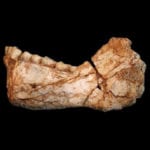 History
History  History
History  Creepy
Creepy 10 More Representations of Death from Myth, Legend, and Folktale
 Technology
Technology 10 Scientific Breakthroughs of 2025 That’ll Change Everything
 Our World
Our World 10 Ways Icelandic Culture Makes Other Countries Look Boring
 Misconceptions
Misconceptions 10 Common Misconceptions About the Victorian Era
 Mysteries
Mysteries 10 Strange Unexplained Mysteries of 2025
 Miscellaneous
Miscellaneous 10 of History’s Most Bell-Ringing Finishing Moves
 History
History 10 Great Escapes That Ended Right Back in Captivity
 Weird Stuff
Weird Stuff 10 Fascinating Things You Might Not Know About Spiders
 Food
Food 10 Everyday Foods You Didn’t Know Were Invented by the U.S. Military
 History
History 10 Most Influential Protests in Modern History
 Creepy
Creepy 10 More Representations of Death from Myth, Legend, and Folktale
 Technology
Technology 10 Scientific Breakthroughs of 2025 That’ll Change Everything
Who's Behind Listverse?

Jamie Frater
Head Editor
Jamie founded Listverse due to an insatiable desire to share fascinating, obscure, and bizarre facts. He has been a guest speaker on numerous national radio and television stations and is a five time published author.
More About Us Our World
Our World 10 Ways Icelandic Culture Makes Other Countries Look Boring
 Misconceptions
Misconceptions 10 Common Misconceptions About the Victorian Era
 Mysteries
Mysteries 10 Strange Unexplained Mysteries of 2025
 Miscellaneous
Miscellaneous 10 of History’s Most Bell-Ringing Finishing Moves
 History
History 10 Great Escapes That Ended Right Back in Captivity
 Weird Stuff
Weird Stuff 10 Fascinating Things You Might Not Know About Spiders
 Food
Food 10 Everyday Foods You Didn’t Know Were Invented by the U.S. Military
10 Amazing Things We’ve Found Inside Diamonds
Diamonds are not only a woman’s best friend. They are also a geologist’s best friend. These precious stones sometimes contain unbelievably rare or unseen elements that reveal the deepest secrets buried in our Earth.
By analyzing diamond finds, scientists have been able to guess what lies underground and have even uncovered some facts about the history of our Earth. In rarer instances, these diamonds come from outer space.
10 Ringwoodite
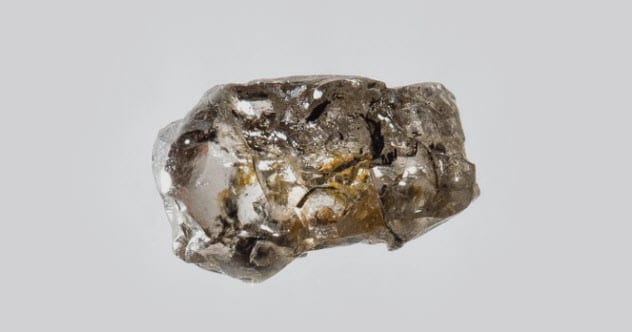
Scientists believe there is an ocean inside the Earth’s mantle. This ocean is inside a green mineral called ringwoodite, which only exists between the lower mantle and the transition zone 515 kilometers (320 mi) inside the Earth. The transition zone is between the upper and lower mantle.
Ringwoodite does not exist overground because it can only be produced under the insanely high pressures that occur deep underground. Scientists have gotten their hands on it a few times, but it always changed into another form in the absence of the massive underground pressure. However, geochemist Graham Pearson managed to get ringwoodite in its natural form.[1]
The ringwoodite was trapped inside a diamond found in a mine in Juina, Brazil. Pearson and his colleagues suggested that it was brought to the surface during an earthquake. Pearson made the discovery by chance. He was actually trying to date the diamond when he discovered that it contained ringwoodite.
9 Calcium Silicate Perovskite
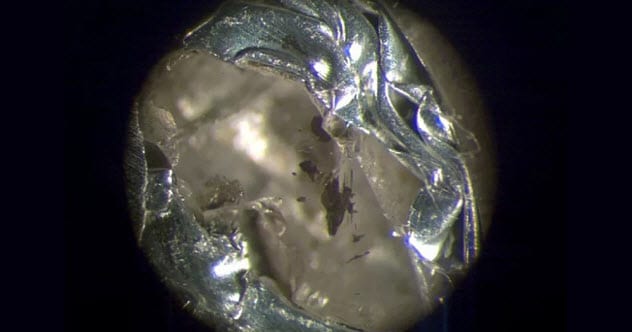
Paradoxically, silicate perovskite is a rare mineral even though it is the commonest mineral on Earth. Scientists believe that 38 percent of the Earth’s volume is comprised of silicate perovskite. Yet it is so rarely found that our first sample came from a meteorite believed to have broken off from another planet. We cannot lay our hands on Earth’s silicate perovskite samples because they only exist inside the Earth’s mantle.
However, that changed when scientists found a stable sample inside a diamond that was just 1 kilometer (0.6 mi) underground in Cullinan Diamond Mine in South Africa. The actual mineral is calcium silicate perovskite (CaSiO3), which is believed to be the fourth most common mineral on Earth.
Interestingly, the diamond that contained the sample is one of the rarest diamonds on Earth. It is only formed around 700 kilometers (435 mi) underground where the pressure is 240,000 times greater than on land. Scientists believe that the calcium silicate perovskite sample got trapped inside the diamond as it formed.[2]
8 Ice
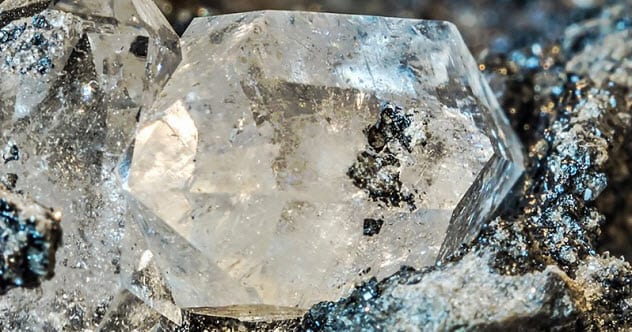
As we mentioned earlier, scientists have speculated about the existence of an ocean inside the Earth’s mantle. Scientists believe that this ocean was formed when water from the planet’s oceans was dragged underground by parts of the sinking Earth crust.
Scientists know that the Earth’s crust is still sinking into the mantle. But they cannot determine how long it has been sinking or the size of this ocean. For all we know, it might not even exist. However, recent discoveries suggest the existence of this ocean.
In March 2018, it was reported that scientists had discovered ice samples trapped in diamonds that formed in the Earth’s mantle. They believe that the ice was created from part of the water dragged into the mantle. This discovery becomes more interesting when we realize that the interior of the Earth is very hot and ice doesn’t form in hot environments.
Scientists call this ice-VII, which is only formed between 610–800 kilometers (379–497 mi) underground where the pressure is over 24 gigapascals. Three samples of ice-VII have been found in diamonds so far—two from mines in South Africa and a third from a mine in China.[3]
7 Liquid Metals
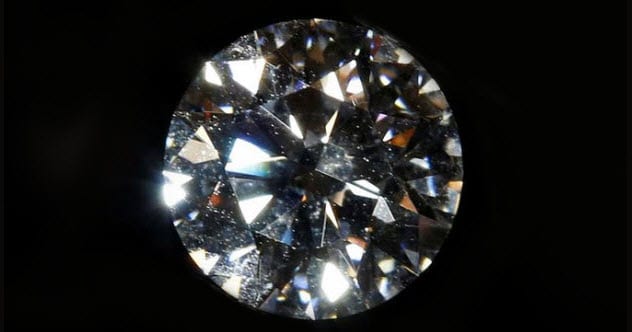
All the largest diamonds ever found were formed deep inside the mantle between 322–805 kilometers (200–500 mi) underground. These diamonds sometimes contain impurities, which are actually metals present inside the Earth’s mantle. Scientists often study these diamonds to have an idea of what’s inside the mantle.[4]
By analyzing 53 of these diamonds, scientists have discovered that the Earth’s mantle contains lots of iron and nickel as well as trace amounts of methane, hydrogen, and garnet. Interestingly, they did not find any trace of oxygen. This counters the belief that there is an abundant amount of oxygen inside the mantle.
6 Harzburgitic Inclusions
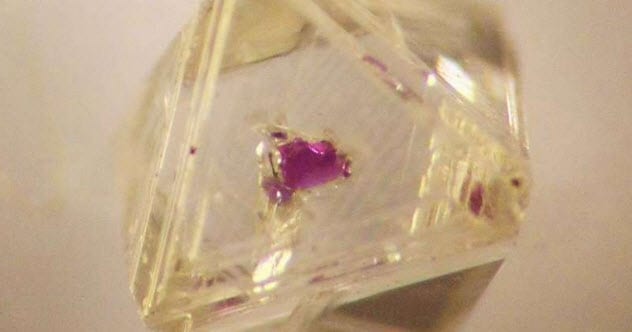
Harzburgitic inclusions are a type of rock you have probably never heard of. They are a subcategory of peridotite rocks, which are the commonest rocks found in the Earth’s mantle. Due to their abundance in the mantle, scientists often date diamonds by dating the harzburgitic inclusions they contain.
Some researchers at Vrije University in Amsterdam made an interesting discovery when they dated 26 diamonds containing harzburgitic inclusions. Nine of the diamonds were formed about three billion years ago when a big continent broke up into smaller continents and created superhot situations deep underground.
They discovered 10 of the diamonds were just 1.1 billion years old, which is really short in Earth’s timeline. In fact, this was the first time that scientists were finding one-billion-year-old diamonds. These precious stones are usually billions of years old because the Earth was exceedingly hot at the time. The planet was too cool to produce any diamonds one billion years ago.[5]
However, scientists believe that a huge volcanic eruption in today’s Zimbabwe provided the required heat to create these young diamonds. Their discovery sheds a new light on diamond mining because miners often test for the age of harzburgitic inclusions in prospective mines.
5 Boron Molecule
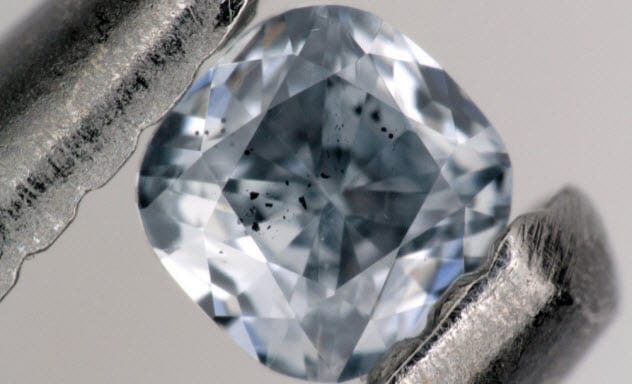
As a rule of thumb, carat weight is one factor that determines the value of a diamond. The higher the carat weight, the higher the price, and vice versa. However, the diamond’s color (which is caused by the presence of other minerals) also determines the price. The rarer the color, the higher the price. Blue diamonds are the second rarest diamonds, and they are quite expensive. (Red diamonds are the scarcest.)
In 2016, the 24.18-carat Cullinan Dream blue diamond was auctioned for over $23 million. Blue diamonds are rare because they are the deepest-forming diamonds. They are created deep inside the lower mantle between 410–660 kilometers (250–410 mi) underground. For comparison, regular diamonds are formed between 150–200 kilometers (90–125 mi) underground.
Blue diamonds are blue because they contain boron, which is rarely found underground. The majority of the world’s boron supply is found overground in the Earth’s oceanic crust. So, how did boron get deep into the lower mantle and even inside the world’s deepest and second-scarcest diamond?
Scientists are unsure, but they suggest that boron enters the ground when a denser tectonic plate crashes and goes underneath a less dense tectonic plate. The boron on the dense tectonic plate then makes its way underground along with methane, hydrogen, and ocean water.[6]
4 Kyanite

Although it is rare, diamonds sometimes turn up with another precious gemstone, such as a ruby or kyanite, inside them. We already mentioned that diamonds appear blue when they contain boron, but they could also appear blue if they contain kyanite.[7]
Kyanite can also be gray, green, orange, white, yellow, or even colorless. Blue kyanite is the most valuable even though white kyanite is rarer. Fraudulent sellers sometimes pass off blue kyanite as the costlier blue sapphire.
3 Mutated Carbon Atoms
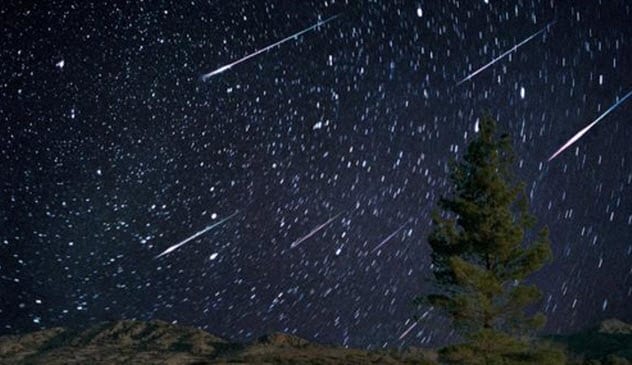
Pure carbon exists in three major forms: diamond, graphite, and buckminsterfullerene. However, scientists have discovered two other forms that contain mutated forms of carbon, making them harder than diamond. Interestingly, scientists predicted the existence of these crystals long before confirming their existence.
The superhard crystals were not found here on Earth. Instead, they were from the ureilite-class Havero meteorite that crashed in Finland in 1971. This type of meteorite often contains graphite and diamond.
Scientists believe that the superhard crystals were originally graphite which heated up as the meteorite entered the Earth’s atmosphere. This produced a chemical reaction that caused the carbon atoms to mutate and create the superhard crystal.
Unfortunately, scientists could not determine the hardness of the crystals because they were too small. However, they knew that they were harder than diamond because they could not be polished with diamond paste.[8]
2 Carbon-12
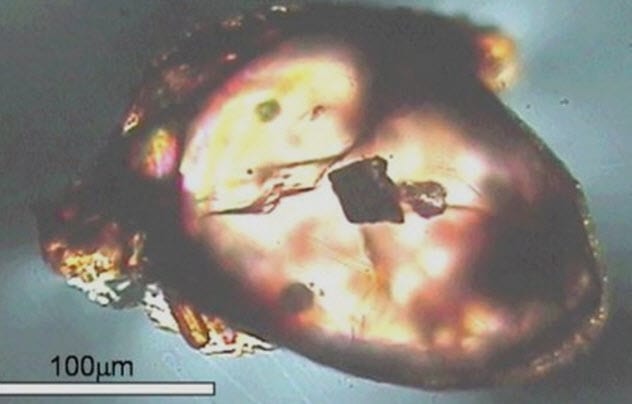
In 1983, some researchers from Curtin University in Australia found 22 diamonds inside some zircon crystals in Jack Hills in Western Australia. A study of the diamonds revealed that they were made of carbon-12 (aka light carbon). The find was fascinating because diamonds containing huge amounts of carbon-12 are only formed when there are living organisms around.
Scientists determined that the diamonds were created 4.2 billion years ago, while the zircons were formed 4.4 billion years ago. Scientists have always believed that the first single-cell organism appeared 3.5 billion years ago. However, the diamonds have proven that single-cell organisms probably existed during the Hadean eon 700 million years earlier.
At that time, Earth was a terrible place to live, even for the smallest organisms. The planet was extremely hot back then. The ocean was filled with superhot magma instead of water. Scientists suspect that the carbon-12 could have been brought to Earth by meteorites if it was not created by living organisms.[9]
1 Ferropericlase
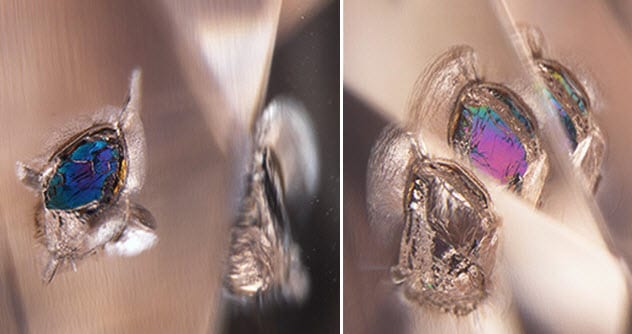
It is rare to find diamonds formed very deep inside the Earth’s mantle. However, researchers at the Gemological Institute of America (GIA) believe they may have found some. These diamonds contain ferropericlase, which exists deep inside the Earth’s mantle.
Diamonds containing ferropericlase are easily recognizable because they are iridescent. They will change their color depending on the angle at which they are viewed and the angle from which light hits them—much like when you view light through a soap bubble. No one knows why ferropericlase diamonds behave this way, but the presence of fluid or magnesioferrite has been fingered as a possible reason.
However, not all diamonds containing ferropericlase reflect colors. Some just appear transparent brown. Besides, the presence of ferropericlase is not enough evidence to prove that a diamond was created in the mantle. Ferropericlase diamonds could also be formed high above the mantle in areas where there is a short supply of silica.[10]
Read more fascinating facts about diamonds and other gems on Top 10 Reasons Diamonds Are Not As Great As You Think They Are and Top 10 Rarest Gems.



